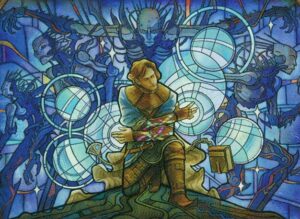Some people discuss deck building and deck tuning as different skills—there’s an idea where some people are good at coming up with big picture original new ideas, and some people are good at fine tuning an existing deck to get the last few cards right. Maybe there’s some truth to it, but for me, the line between these isn’t so clear.
My deck building process is extremely iterative. When I’m working on something new, I change a lot of cards very quickly. In fact, what I’ve found most fun about cEDH specifically is almost every time I play, I identify some change I want to make. With so many different cards involved, it’s almost impossible for all of them to be optimal. The more I play, the more I develop a sense of what I need and which cards aren’t pulling their weight.
The best part about this is the feeling of leveling up, getting more powerful every time I play. My (Jhoira) deck already feels good, and wins often. But every time I play it, it gets better. It’s a great feeling.

Raff, Weatherlight Stalwart illustrated by Ivan Shavrin
When Playing Good Cards Isn’t Good Enough
It’s not always so easy. Jhoira was pretty strong out of the gate, but some ideas come up short, or need a lot of work. I have an ongoing project which isn’t ready for cEDH yet, but I still mostly think it’s in its range. That project is Raff, Weatherlight Stalwart.
I played Raff in a somewhat competitive budget league where I imposed a restriction on myself. I wouldn’t search my library, because I think searching makes paper Magic less fun, especially in multiplayer games. Others didn’t have this restriction, so there were a lot of combo decks in the league. My deck was a control deck with around 50 instants. My goal was to never be the most immediate threat in the early game so other players would damage each other and trade resources while I’d sculpt my hand, develop my board, and make sure no one outright won the game. Eventually, other players would be worn down while I’d have built up enough to take control of the table.
I don’t think there’s any reason this strategy shouldn’t work in cEDH. It’s a question of how to make it as strong as possible.
I tried a light conversion but kept it close to the budget league deck. I shared it and received feedback that it wasn’t a cEDH deck because it didn’t play the staples in my colors, and it wasn’t strong enough. I figured I’d trust the assessment, so I rebuilt it with more staples.
I cut most of the token making and played all kinds of hatebears and stax pieces. Every Stony Silence, Null Rod, Rest in Peace, Grafdigger’s Cage, Eidolon of Rhetoric, Hushbringer, Cursed Totem, Back to Basics, etc. I packed nothing which interacted with my graveyard, no creatures with enters the battlefield effects or activated abilities (outside of Raff), and minimal artifact mana.
The deck was absolutely horrible.
I could slow the table down for awhile, but I wasn’t building to anything. I didn’t have enough of an engine to churn through my deck and sculpt a hand. Eventually I’d draw into a pocket of lands and lose horribly. It was hard to even figure out how I might win.
Back to the drawing board.
Iterating, Iterating, and Iterating Again
It’d be easy to give up here, especially since I have another deck I like and no real reason to make this competitive. But, solving the problem is fun for me. I haven’t tested my new attempt, but it’s taken big steps toward going back to its roots.
My deck is mana, creatures, and instants, and sorceries. No Null Rod, no Back to Basics, no Rest in Peace, and most surprisingly, and controversially, no Mystic Remora or Rhystic Study.
I feel pretty strongly that not playing those cards in particular is correct for this deck. I’m not, in any way, debating the strength of either card in cEDH, but that’s not the point.
So why are these bad in this deck? There are a lot of different points here.
First, politics and table threat assessment. This deck is trying to be the good guy in the early game. “I’m not going to win anytime soon, but I’m going to protect you if that combo deck tries to win.” If you have Mystic Remora or Rhystic Study, you look like an immediate threat, even when you aren’t.
Second, these cards have variable and unpredictable outputs—sometimes they draw a lot of cards, sometimes the table can play around them and they draw few cards. For most decks, that’s great—if they don’t do much, it didn’t really cost much to play them. Maybe it slowed down the rest of the table and that’s worth the card. Other times, the table lets you draw into an explosive game winning turn. The problem is this deck has no way to capitalize on the ceiling—I can’t turn drawing a bunch of cards early into winning the game. I discard a bunch and sculpt a slightly better hand, but even my end game doesn’t really rely on having a sculpted hand early. It revolves around consistent development.
This is pretty hard to wrap your head around if you haven’t seen the deck play.
For every two creatures you have, the first spell you cast each rotation cantrips. So if you have six, the first three spells you cast cantrip. You’re trying to build up enough creatures so every spell you cast cantrips, and enough lands so you can cast as many spells as you need to to answer everything that happens once the table is trying to kill you. This is impossible without playing a long game first.
Most cEDH decks are probably trying to win on Turn 2-5. My Jhoira deck is trying to play a long game and win on something like turn 8 or so. This deck is legitimately trying to win on turn, I don’t know, 15 or so? Maybe that’s not realistic, but I think it is realistic, and more importantly, I don’t think the deck gets better if I try to change that plan. The deck can only be good by making the game about what it does best, which is that. Otherwise it’s merely a bad version some other deck.

Mystic Remora illustrated by Kelogsloops
Forgoing the Fish
Cards with variable outputs are weaker when you can’t capitalize on their ceilings, which this deck can’t.
Further, and more importantly, there’s no turn when I want to play Mystic Remora. With most decks, you can play it pretty early and it draws you into artifact mana that lets you keep paying for it while doing other things. This deck’s artifact mana, a complete list:
End of list.
If I play Mystic Remora before Turn 4 or 5, the cumulative upkeep stops me from developing. Some decks don’t care; drawing a lot of cards is worth not playing to the board, or not having mana up. But it’s not how this deck works. I can keep my hand full without a burst of extra cards in the early game, but I need to be playing creatures in the early game to do that, and I need my mana for that.
Another point is that these are horrible draws late in the game. I draw so many cards in the late game, so it’s way more likely I see them in the late game than in the early game. My deck’s entirely about card velocity, and hitting random enchantments I can’t cantrip through with Raff to find what I need can be a death sentence. Also, in the late game, people can afford to pay for Rhystic Study.
The things these cards do best is let me fight against decks that cast lots of spells, but those are typically combo decks I’m relatively well positioned against anyway. It’s not where I need the help.
I want to be clear, I’m not arguing that these aren’t among the strongest cards in cEDH, or that your deck or any others shouldn’t play them. I play both in my Jhoira deck, and I think they’re pretty good there. I think they’re absolutely awful in Raff the way that I want to build and play the deck.
My perception is the community is a little too invested in identifying which cards are “good” and “bad,” rather than thinking about the specific needs of decks. When someone says “My deck isn’t cEDH because it’s blue but doesn’t have Mystic Remora”, it feels like someone telling me Creativity isn’t a competitive Modern deck because it doesn’t play Ragavan, Nimble Pilferer.
Anyway, I didn’t really want this article to be about my decision to not play these enchantments. My real point is if you’re following a vision for a deck with a specific plan, it’s ok to lean into it and forgo some staples to make it happen. “Good cards” is almost never the best archetype in any competitive constructed format, but it seems like “I stack-ranked every card in cEDH and here are the 99 best ones” is a reasonably popular way to build cEDH decks. It seems wrong to me.
Wait, that’s not my real point, that’s just the point I was trying to illustrate by talking about Study/Remora. I was actually talking about iterating on decks.

Scroll Rack, illustrated by Heather Hudson
Lessons from the Old Bordered Past
I intend to focus on commander type play in this column, but it’s worth mentioning how at the time of writing this, I recently won a Premodern tournament. Premodern is a format which allows cards from 4th edition through Scourge (cards before the modern frame) with its own banned list. I won this tournament with a deck I built several months ago and have been tuning gradually over several tournaments. The first time I played it, I had never played the format. I discovered there were a lot of strong, fast combos which could beat my control deck before I’d established my card draw engine to find my answers.
After the tournament I addressed this by adding four Annul to my sideboard (because every combo deck in the format is based on artifacts or enchantments) and added Foil to my maindeck.
In my tournament, I lost to The Rock, and Green-Black midrange deck with discard and Pernicious Deed. My deck, which uses Land Tax and Scroll Rack to set up an engine that draws absurd numbers of cards is weak to Pernicious Deed. I have counterspells to stop it, but because they have discard in the form of Duress and Cabal Therapy, it’s not reliable.
After the tournament, I addressed this by adding Meddling Mage to my sideboard and Gush to my maindeck, so I’d be better against discard and better against Pernicious Deed. Meddling Mage could stop them from playing it, and they wouldn’t likely have many other ways to kill Meddling Mage.
After each of these events, my deck got much better than it had been, which made me really excited to play it again. It made events really fun for me. This is the same experience I’m having with cEDH.
Incidentally, the reason I’m having more fun with cEDH than EDH isn’t the game play, it’s that after I play and learn something, I get to reflect and improve my deck between games. In casual EDH, I could identify cards which aren’t contributing to winning and remove them. But then my decks would get stronger than where I want them to be. Yes, I’m sure many players can meaningfully tune their deck to be more fun, but that kind of iteration isn’t the kind that speaks to me. I want more concrete objectives.
I’m not exactly sure where I’m going with all this—like, what’s my point? I guess I thought it would be interesting to focus a bit more on the process, to highlight that there are projects that are always on the back burner that you don’t hear about because they’re less successful than the thing that’s worth showing off. To talk a bit more about my general process and approach. I think I stand by the idea that that’s broadly worth sharing, but I think I have to leave what takeaway you should have from that as an individual exercise for each particular reader.
Sam Black (any) is a former professional Magic player, longtime Magic writer, host of the Drafting Archetypes podcast, and Twitch streamer. Sam is also a Commander Cube enthusiast, and you can find Sam’s cube list here. For anything else, find Sam on Twitter: @SamuelHBlack.

